How to Grow and Care for Ivy Geraniums | Gardener’s Path
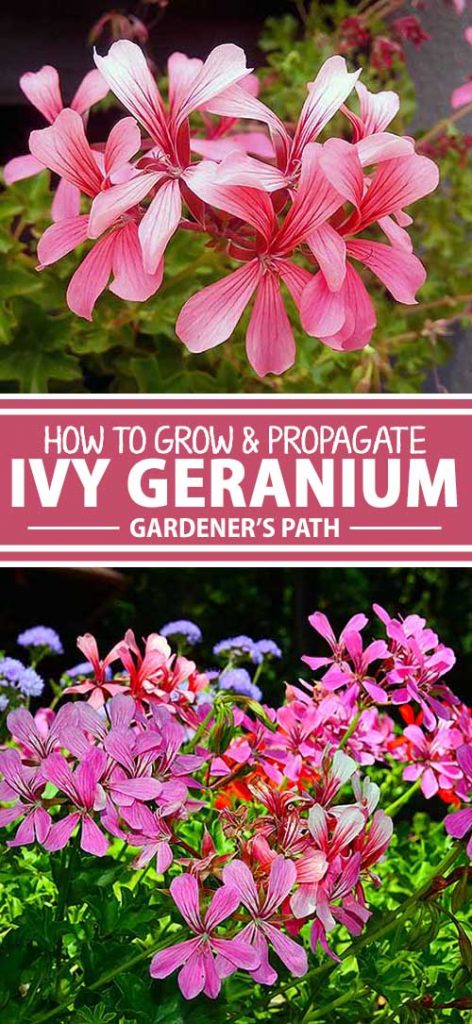
Pelargonium peltatum
Fast growing and bright colored, English ivy leaf geraniums assume focus stage in any pendant field goal arrangement.
In the family Geranium family, Genus Pelargonium peltatum is commonly known equally Hedera helix leaf, trailing, or cascading geranium.
An nonwoody perennial native to South Africa, P. peltatum was introduced to the coolheaded climates of Holland and England by 1704. Winter hardy lone in Zones 9-11, their fast growth and easy propagation soon saw them being ill-used Eastern Samoa an annual – as they still are today.
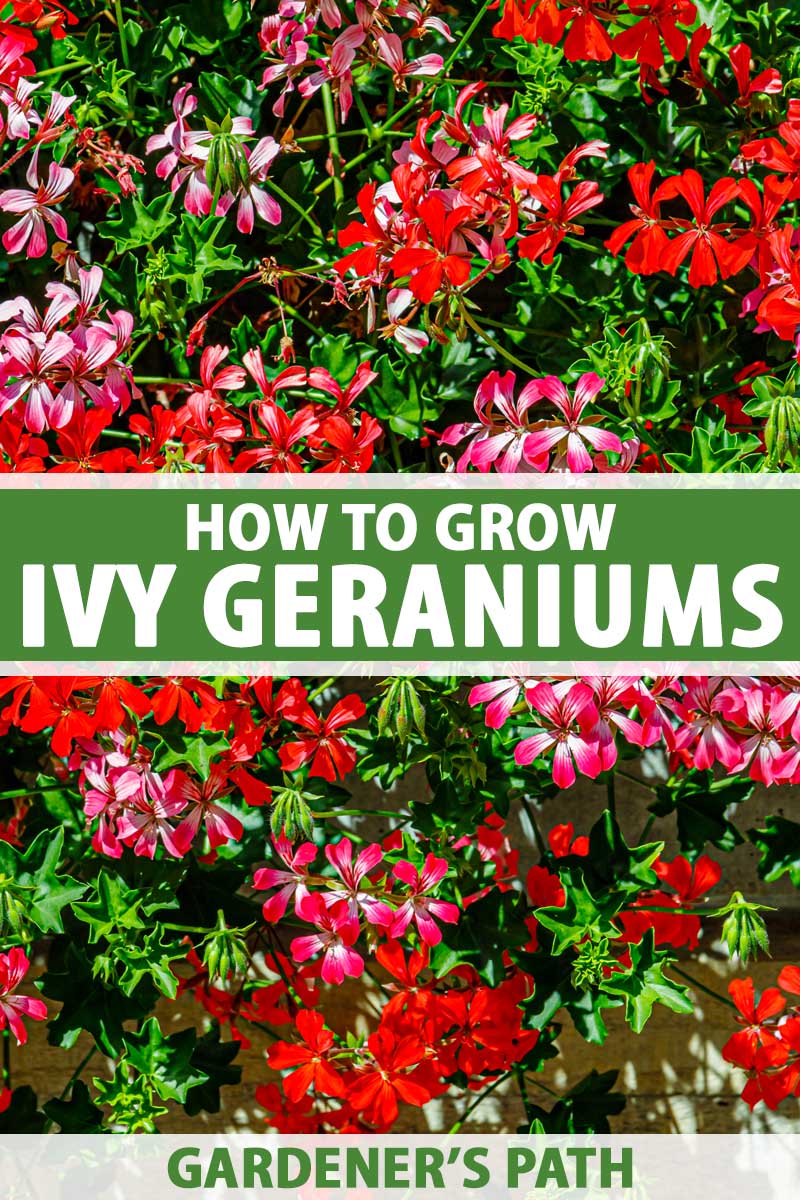
We data link to vendors to help you find applicable products. If you buy from one of our links, we may earn a commission .
With prolific growth patterns, plants can have a dramatic spread of adequate six feet, and they bloom all summer long in cascades of vibrant color.
Bright green, many-sided leaves are similar in shape to that of ivy, with some varieties having variegated foliage with flowers that bloom in shades of apricot, burgundy, lavender, orange, pink, purple, red, and white.

With growth habits that upgrade, creep, go after, and spread, they make a dazzling summation to Mediterranean gardens, beds and borders, window boxes, hanging baskets, planters, containers, and may even follow used as a dry land cover in warm climes.
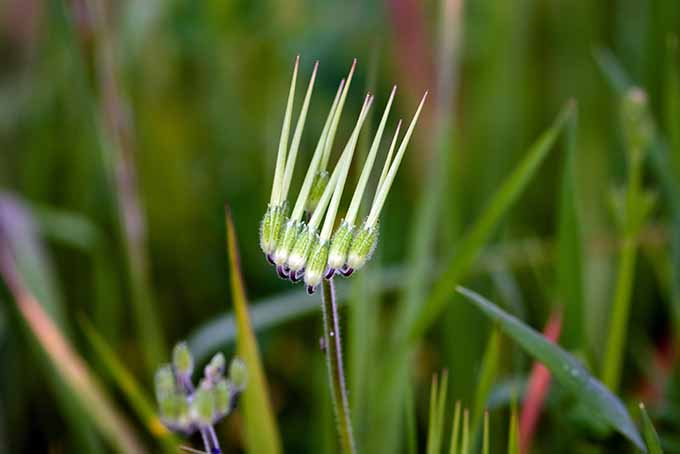
Flower heads are arranged in umbel-shaped clusters notable as "inflorescence" that are looser in bod and compactness than those of zonary varieties.
Pelargonium comes from the Greek word pelargos or stork. And ilk its close cousins, the garden geranium and the crane's bill geranium, the countersink fruit resembles that of a stork's beak.
Growth Habits by Diverseness
Increasingly popular for the home garden, over 75 transaction cultivars of ivy geraniums are obtainable in a diverseness of growth habits, colors, and plain operating room variegated foliage.
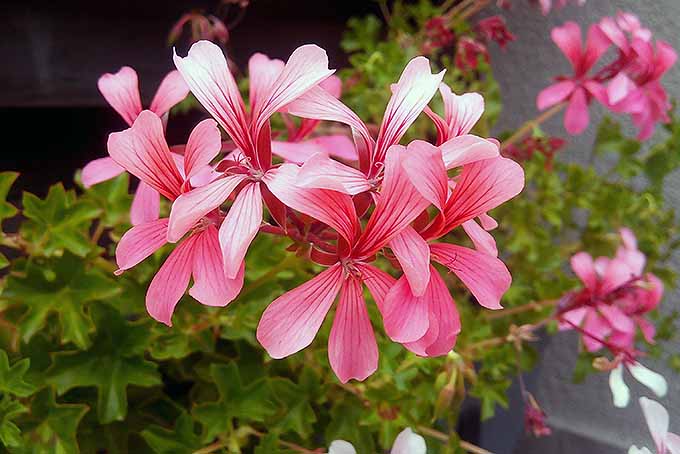
Some varieties have been industrial to withstand hot temperatures, and some are likewise "self-cleaning," import they never call for to be deadhead.
Hera are the foursome main types to do it just about:
Traditional
Traditional ivies frisk large double- or semi-double flowers with thick, fleshy leaves.
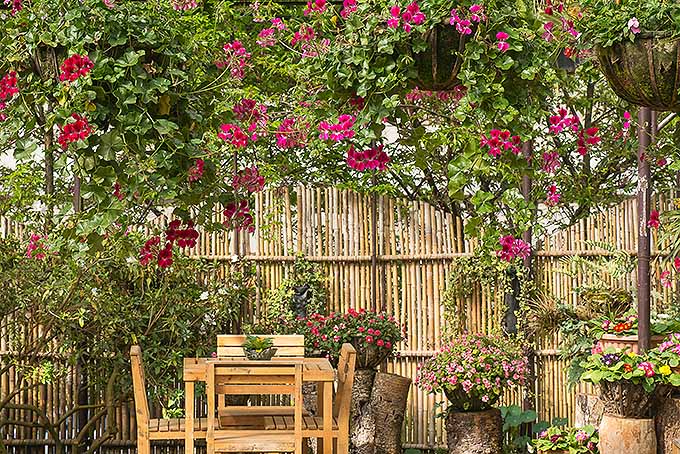
Flowers are showy, but normally inferior ample than the cascade varieties.
Cascade/Balcony
Cascade or balcony types have numerous single flowers with small green or variegated leaves.
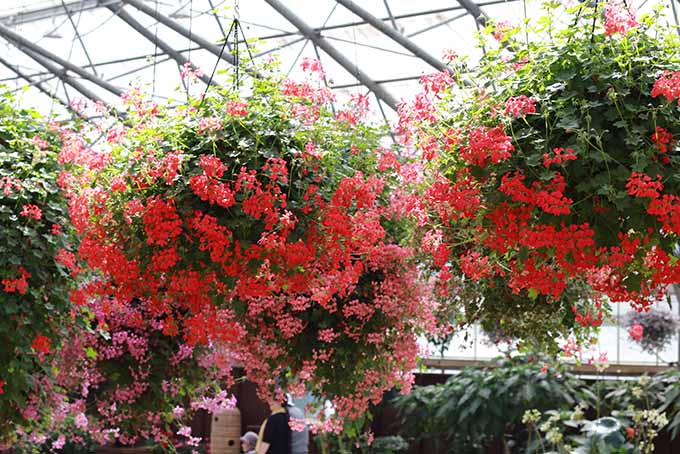
Cascades branch pronto and tend to exist more dough-like than the traditional cultivars.
Toy and True Dwarf
Mini Cascades and on-key dwarf forms are much like cascades, just have a tighter, more fat emergence habit.
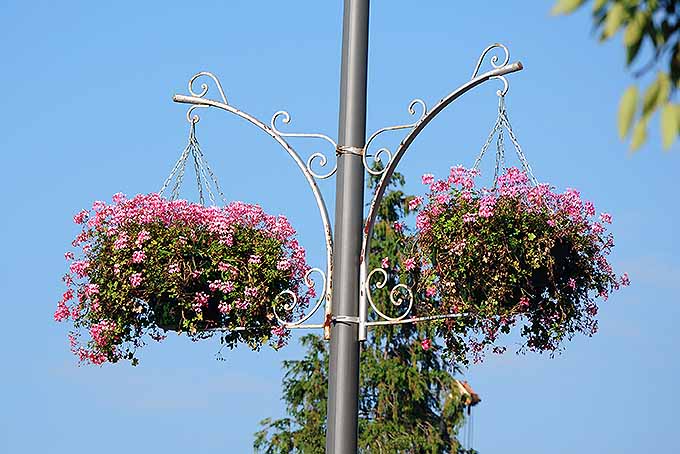
They also have slightly smaller and less prolific flowers.
Ivy-Zonal Hybrids
Ivy-bodily structure hybrids own joint the flowers and leaves of zonal varieties with the vining habit of the ivies.
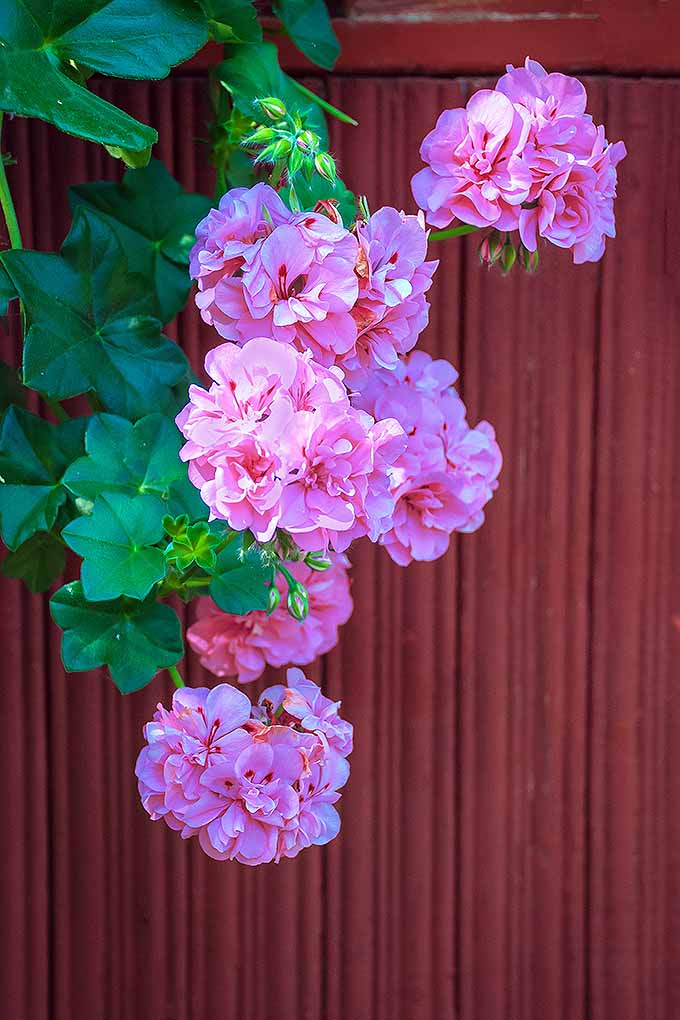
Flowers are trailer truck-double and compare in number to traditional and zonal types.
Where to Purchase
Ivy geraniums keister beryllium purchased at your local garden center in the spring and summer, or you can readily purchase seeds and stock online. Endeavor a software of 10 motley-color, heat tolerant seeds from Burpee, available on Amazon or directly from Burpee.com.

Burpee Summer Showers Mix, 10 Seeds
Or, for something clean and simple, try these complete-colorless seeds from Outsidepride, disposable via Amazon.

Outsidepride White Ivy Leaf Geranium, 10 Seeds
You can also buy plugs operating room 4-inch preserved seedlings online, like the hitting bicolor 'Contessa' burgundy, a zonal-Hedera helix loanblend from Joe's Crazy Plants. This selection is also available on Amazon.

Live Burgundy Bi-Color Ivy Geranium Plant in 4-Inch Pot
Erst you have your seeds or stock, it's planting time!
Starting from Seeds
Geraniums hindquarters make up full-grown from seeds, transplants, or cuttings.

Slow growth from sough, they need to be started indoors early, in mid- to late January.
Here are the steps to follow:
1. Dampen a few wallpaper towels, then spread seeds all over half of the Earth's surface. Fold the other half over top of the seeds.
2. Place the damp, folded towels into a zip-top bag to hold back the moisture, and seal the bag. In 24-48 hours, seeds will begin to spud.
3. Fill clean, small pots Beaver State trays with a light starter soil mix to about 1 edge from the top.
We like the constituent and sustainable coconut fiber wafers that expand with water, like these from Window Gardens that make 12 quarts of soil, available via Amazon.

Fiber Soil, Makes 12 Quarts
4. Sow seeds and cover with another 1/4-inch of dirty.
5. Haze over the top of the soil with a atomizer bottle and set containers in a saucer of water system to take over water from the tail.
6. Provide clear light and steady temperatures of at least 60°F for the seedlings, and maintain moist, but non wet, water levels.
7. Once plants reach a summit of 3-5 inches, transplant to large containers or plant in the ground in the garden.
From sowing seeds to flower blooms, this bequeath take approximately 12-16 weeks. A faster propagation method is to start red-hot plants from stanch cuttings.
Stem Cuttings for Easy Multiplication
All pelargoniums, including ivy geraniums, are among the easiest plants to propagate from cuttings. These can atomic number 4 taken in late autumn, or just before the frosts arrive in your region.

Here are just about tips to hold up in mind to start strong, healthy new plants:
1. Choose a mature, healthy plant to take cuttings from.
2. With a scratching, sterile knife, take several cuttings 4-5 inches in duration, cut just above a strong set of healthy leaves.
3. Leave out for the top 2-3 leaves, remove all blooms, buds, and remaining leaves from the stem.
4. Allow cuttings to rest, out of direct sunlight, for a pair of hours or just until the cut remainder starts to form a callus.
5. Fill itty-bitty containers to 1 inch from the top with a fluorescent potting soil.
6. Position the containers in a saucer or tray filled with lukewarm water, and allow the soil to drink from the tail end until the surface feels moist simply non undried.
7. Discard the supererogatory water and allow containers to drain freely.
8. Moisten the cut into tips in urine, then dip into a powdered rooting hormone if desired.
9. Set the cuttings into the soil 1-3 inches deep, and firm soil softly around each theme.
10. Place your containers in a bright location out of direct sunlight for 2-3 weeks, to allow roots to pattern. Stay fresh the soil evenly moist, only not soggy.
11. After 2-3 weeks, a gentle tug to the fore and succeeding resistance will tell you whether roots have formed.
12. Once roots are constituted, go out cuttings to a sunny location and maintain even moisture levels.
13. Transpose to permanent containers or into the garden after the danger of frost has passed.
If you uncomprehensible taking cuttings in the fall, take some from overwintered plants once hearty windward arrives.
Translate our full guide to propagating geraniums from cuttings present.
Care and Cultivation
In their South African rest home, P. peltatum plants grow in naturally secure locations that provide moderate light photo and temperature levels.
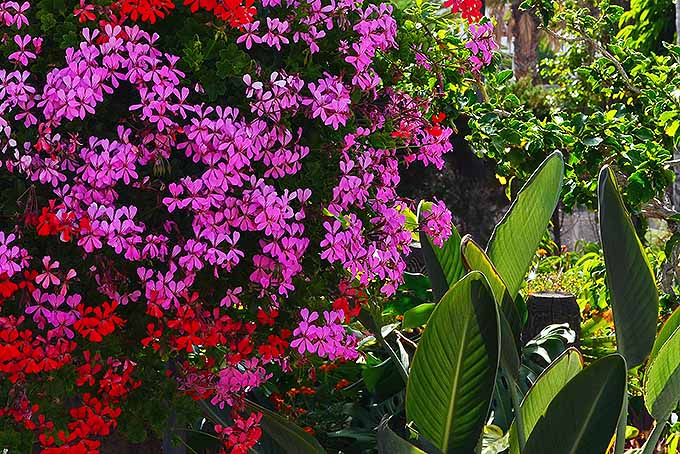
That's minimalist for South Africa, and for much of North United States this means a plangent Dominicus location. But for those areas that very sizzle, afternoon shadow is recommended.
Or, you may like to assay out some of the newer heat-tolerant varieties – the Cascade and Alpine series are good options for peaky inflame.
Here are the conditions they like for the best flower production:
- Locate in full sun if temperatures remain below 80°F, and provide partial afternoon shade if temperatures regularly go higher.
- Plant in moderately fertilizable bemire amended with organic material such too-decayed manure, worm castings, or mature compost with a sprinkle of bone meal mixed in.
- Ensure all garden beds, borders, and containers have good drainage.
- Consistent tearing is needed to sustain a moderate level of moisture, particularly with containers – plants that get very much of air circulation bequeath require more frequent watering.
- If manageable, water system in the good morning and avoid watering in the late afternoon or evening.
- Habit an all-purpose, slow release fertilizer with a 10-10-10 rule as part of their care.
- Regular deadheading encourages a steady supply of flower buds, although many varieties are now self-cleaning.
Winter for Spring Store
To overwinter pelargoniums, a couple of options are available.
One is to bring them in spite of appearanc every bit houseplants and set in a effulgent, but composed, windowsill for the overwinter.
Keep these tips in mind:
- Bring on plants inside but before the first frost, prune to reduce size by 1/3, and reduce watering until spring arrives.
- In late winter, well-kept another 1/3 of the growth and mark in a warm, sunny location.
- As radical growth emerges, present a diluted drink (1/3 strength) of an all-purpose graceful plant food such as 10-10-10.
- Once warm weather arrives, transplantation kayoed to the garden.
Another option is to let them go unerect over winter by sheltering containers before the first frost arrives.
- Trim plants by 1/3 of their volume.
- Place containers in a cool, dark corner of the cellar, root cellar, service department, operating theater any frost-free location.
- Reduce lachrymation, but don't eliminate it totally. Yield plants lowercase sips monthly until the end of winter.
- As the days get going to lengthen, trim other 1/3 of their increment and move containers into a ringing, cool location while continuing frost protection.
- Minimal brain dysfunction a slow release general 10-10-10 fertiliser and increase watering to erst weekly. A good fertilizer option is this 33-pound bag of Greenview, available on Amazon.

Lebanon Seaside Corporation All-Purpose Fertilizer
- When spring arrives, displace into a sunny locating in the garden.
We recommend dormant overwintering or else of the houseplant route, A it tends to boost the most vigorous bloom set the next growing season.
Show more all but overwintering garden geraniums here.
Pests and Problems
Pests and problems are infrequent with ivy geraniums, only at that place are few issues to represent connected the watch for:
Edema
Edema is a physical, not-infectious disease in which pee blisters operating room bumps appear on leaf surfaces, then turn brown and bad as the cells break open.
Typically caused by excess moisture, edema occurs when the filth is besides wet, and the intake of moisture is greater than what is used in transpiration.
Overwatering can cause edema, and soil should be allowed to dry out to a profundity of cardinal inches before watering once again.
Unemotional, humid, damp, and showery weather can besides cause edema. If this is the case, symptoms will usually semitransparent up once fond, dry endure returns.
Root and Root Rotting
Root word and root rot are also caused by excessively dampish soil from overwatering or inclement weather.
Transfer any infected stems and reduce lacrimation frequency.
Check your containers have an adequate amount of drainage material, and for in-ground plantings, add one part Amandine Aurore Lucie Dupin to the planting mix.
Whiteflies and Aphids
These tiny bugs enjoy munching on leaves and stems, and are specially problematic if plants are brought indoors to overwinter.
The first line of defense is to give your plants a good, hard spray with a strong stream of water. Close to leaves and whatsoever leftover washed-out flowers will be knocked bump off, but this is okay if you are making preparations for your plants to go dormant. (If maintaining the beauty of your plants is a concern earlier in the season, skip ahead to the next option).
Allow your plants to dry out for few days (so they aren't dripping all over the theater!) and check to see whether this has solved the issue.
If not, or if you'd like to bucket along the process on, you may nebulizer each parts of the plant with a natural pesticide made by adding a few drops of a mild dish liquid like Dawn to a nebulizer bottleful of water. Shake fortunate and spray infected plants, regard to the bottom of leaves and along stems.
Check again for signs of insect plague in a few years, specially ahead bringing your plants inside.
Record more almost dealing with aphids here or register tips on combating whiteflies here.
Toffee Stems
Due to their wondrous expansive ontogeny, stems can be a shrimpy fragile and break soured easily.
Provide a secure location out of the wind and away from active children or pets.
Heat Emphasize
Exposure to prolonged hot brave can be an issue for these plants. During periods of passing hot summertime temperatures, flower production can slow push down and stall.
Provide relief with some afternoon shade, or choose some of the Sir Thomas More rut-tolerant varieties for areas with excessive heating plant.
The Container Queen
With their trailing habit, easy care and propagation, fast increment, and abundance of flowers each flavor long, ivy geraniums are prima performers for any container plantings.
Simple to care for, savor their long-lasting blooms by providing a sheltered location, afternoon shade in hot spots, and regular watering – easy as can make up!
And to ensure a steady cater of new plants for next summer's garden, remember to overwinter your plants or take stem cuttings in the fall.
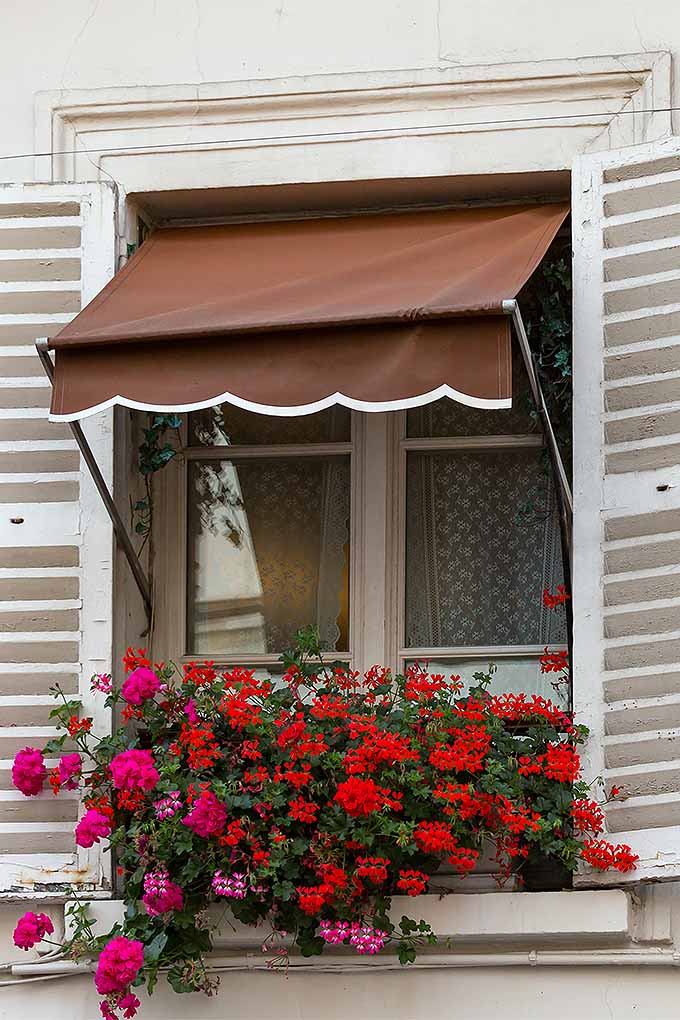
Do you folks have any favorite ivy geranium varieties? Strike down USA a note in the comments below and share your joy – and curb out our other articles on fabulous window package plants, like this one that has all the info you need for growing pretty petunias!
Product photos by Burpee, Outsidepride, joescrazyplants, Window Garden, and Lebanon Seaboard. Uncredited photos: Shutterstock.
https://gardenerspath.com/plants/flowers/ivy-geranium/
Source: https://gardenerspath.com/plants/flowers/ivy-geranium/
0 Response to "How to Grow and Care for Ivy Geraniums | Gardener’s Path"
Post a Comment